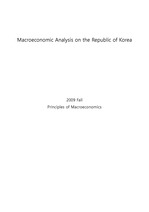

-
미리보기
소개
대한민국의 지난 60년간의 경제 지표들에 대한 거시경제학적 분석을 한 영문 레포트 입니다.목차
I. The Economic Growth in Korea
Introduction
The Korean War and Economic Chaos
Economic Leap
The Upbringing of Heavy Chemical Industry
Economic Stabilization and structural reform
Trade liberalization and opening of Korea’s market
After the foreign exchange crisis
II. Economic Fluctuation of Korea
Introduction
The Energy Crisis
The 3-Low Boom
The IMF Foreign Exchange Crisis
Conclusion본문내용
Introduction
As we have seen in the fist section of this report, Republic of Korea has experienced a rapid economic growth from 1963 to 1996. During these 34 years population has grown 70% and real income per capita has become 10 times larger than before 1963. People name this era of rapid growth (average 8% GDP growth for over 30 years) as the ‘Miracle of Han River’, and many developing nations including Vietnam and Laos are trying hard to follow Korea’s path.
However, even during this era of long term rapid growth, short term economic fluctuation has existed. There were periods of strong economic boom, as well as relative economic recessions. For example, Republic of Korea went through a worldwide economic depression due to the oil shock in the 1970s, but then experienced the largest economic boom from 1986 to 1989. In this section of the report, 3 significant examples of economic fluctuation, from the oil shock to the IMF foreign exchange crisis, will be presented and analyzed.
The Energy Crisis, 1973~1980
The energy crisis, in other words oil shock, refers to the rapid increase in oil price during the 1970’s. The first energy crisis occurred in 1973, and the second energy crisis occurred in 1978. During this period major industrial nations including Korea faced shortage in petroleum.
The first energy crisis was triggered by the 4th Middle East war between Arab and Israel in October 6, 1973. The OAPEC (Organization of Arab Petroleum Exporting Countries) decided to proclaim an oil embargo, in opposition to the US supply to the Israeli military. In October 16, 1973, oil price decision makers of 6 OAPEC member countries gathered in Kuwait, and decided to use petroleum price as a weapon, and agreed to double the oil price. As a result, the oil price became $10.73 per barrel during the first energy crisis, which was about 5 times larger than the oil price before the energy shock ($2.03).
The Iranian revolution triggered the second energy crisis in 1979. Through this revolution, a new regime took control of Iran. Oil exports of Iran stopped entirely during the revolution, and even after the revolution, the oil production in Iran was inconsistent, in a lower volume. Overall, the oil production of Iran dropped 4% due to revolution, but the widespread panic of another energy crisis influenced the international petroleum demand, and pulled the petroleum price. As a result the oil price became over $40 per barrel, which quadrupled in 6 years.
The energy crisis in the 1970s strongly affected the Korean economy. First, the rise in oil price strongly influenced the overall price level. As we have studied during class, the rise in oil price alters the marginal cost curve of each firm. This shifts the market supply curve to the left, and the aggregate price level will rise.참고자료
· Modern History of Korean Economy, Third edition, Lee Heon-Chang, p 431-432, 521 .526 table 1,2
· Macroeconomics, Lee Jong-Hwa, p 4-7, 47
· Change, Samjung KPMG Economy Research Institute
· The understanding of actual Korean Economy, Kim Young Cheul
· Understanding Korean Economy, Kang In Soo
· Economic Statistics system, BOK, ecos.bok.or.kr
· The National Statistical Office
· IMF, International Financial Statistics
· Maddision(Barro and Sala-I-Martin)
· World Bank Statistics, www.worldbank.org태그
-
자료후기
Ai 리뷰지식판매자의 자료는 질이 높고, 각 분야의 전문 지식을 바탕으로 한 콘텐츠가 많아 학습하는 재미가 쏠쏠합니다. 앞으로도 많은 유익한 자료를 기대합니다! -
자주묻는질문의 답변을 확인해 주세요

꼭 알아주세요
-
자료의 정보 및 내용의 진실성에 대하여 해피캠퍼스는 보증하지 않으며, 해당 정보 및 게시물 저작권과 기타 법적 책임은 자료 등록자에게 있습니다.
자료 및 게시물 내용의 불법적 이용, 무단 전재∙배포는 금지되어 있습니다.
저작권침해, 명예훼손 등 분쟁 요소 발견 시 고객센터의 저작권침해 신고센터를 이용해 주시기 바랍니다. -
해피캠퍼스는 구매자와 판매자 모두가 만족하는 서비스가 되도록 노력하고 있으며, 아래의 4가지 자료환불 조건을 꼭 확인해주시기 바랍니다.
파일오류 중복자료 저작권 없음 설명과 실제 내용 불일치 파일의 다운로드가 제대로 되지 않거나 파일형식에 맞는 프로그램으로 정상 작동하지 않는 경우 다른 자료와 70% 이상 내용이 일치하는 경우 (중복임을 확인할 수 있는 근거 필요함) 인터넷의 다른 사이트, 연구기관, 학교, 서적 등의 자료를 도용한 경우 자료의 설명과 실제 자료의 내용이 일치하지 않는 경우
함께 구매한 자료도 확인해 보세요!
-
The problems of the present Korean economy and solutions 9페이지
After the Korean War, most people suffered from serious poverty; in addition, it looked like there was no chance to resuscitate the economy. However, a miracle took place in Korea. After the military .. -
대한민국의 거시경제 분석 16페이지
1950’s Economic Chaos The Korean War(50~53) destroyed over 42% producing power and 44% of manufacturing facilities The Korean Economy experienced a sudden downfall 1949, 9,7% to 1950-51,-15.1%,.. -
재벌에 관한 분석(영문) Brief analysis of Chaebol 4페이지
There are numerous things fundamentally originated from Korea, thus named in Korean-like English, such as Kimchi, Bulgoghi, and so forth. Most of them, however, are now well-famous and easily we can f.. -
[경제]The Government’s Role: The Visible Hand 5페이지
What is the market? Before I took Microeconomics class, I thought it is the real place where we sell and buy products. In the economic point of view, the market means any place where a potential exc.. -
cause of financail crisis 3페이지
Development of telecommunication and transportation lead to expansion of products, services and labor trade as well as capital movement and exchange of information. Especially development of telecommu..
문서 초안을 생성해주는 EasyAI

